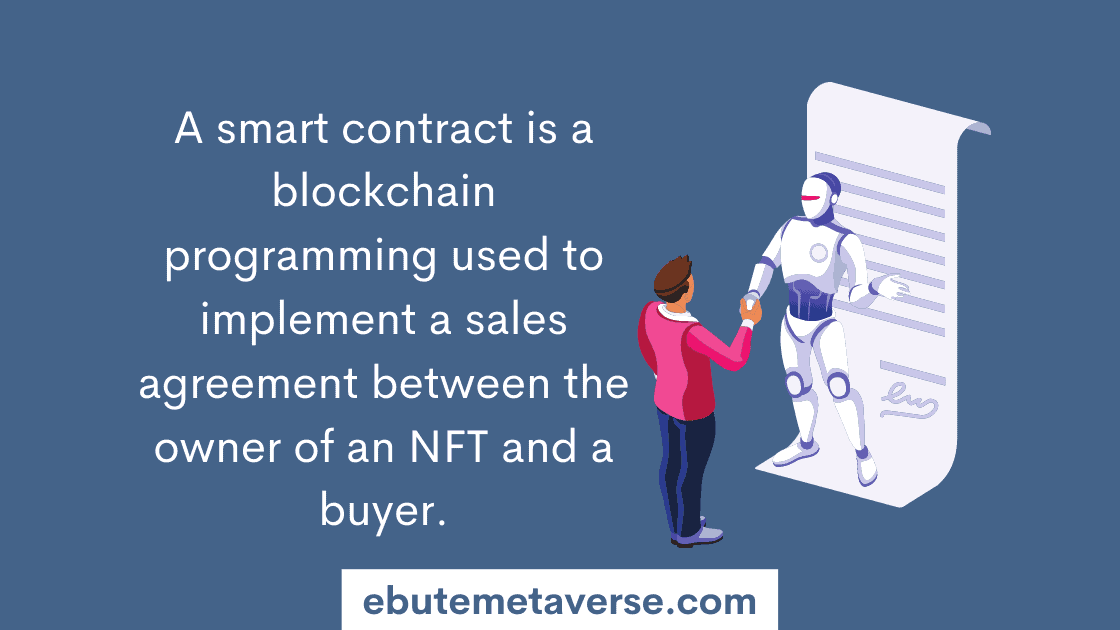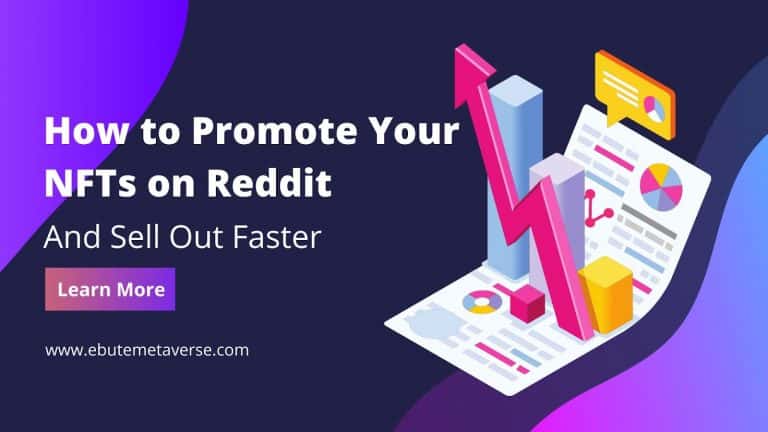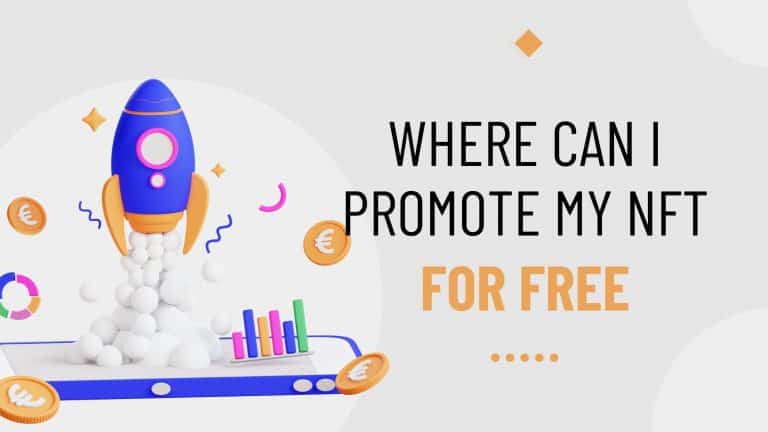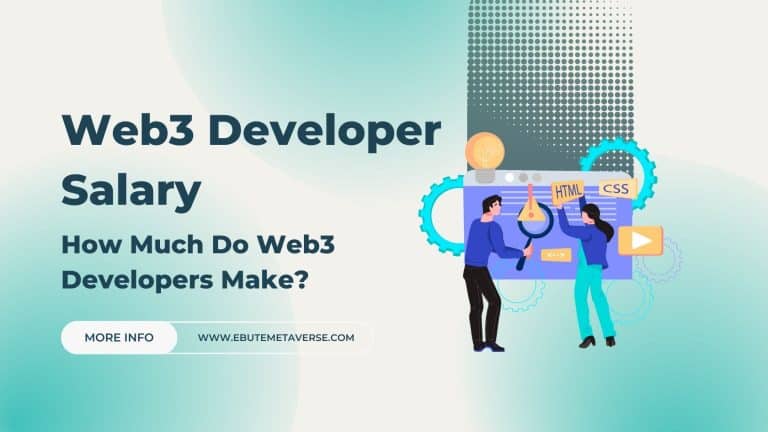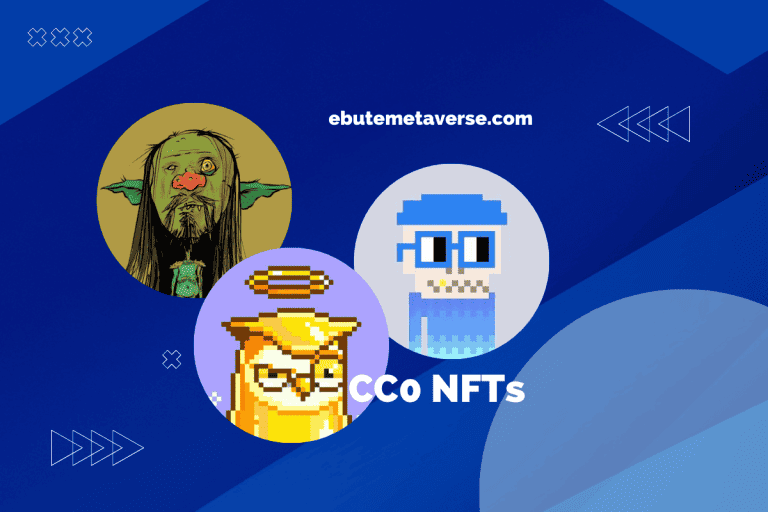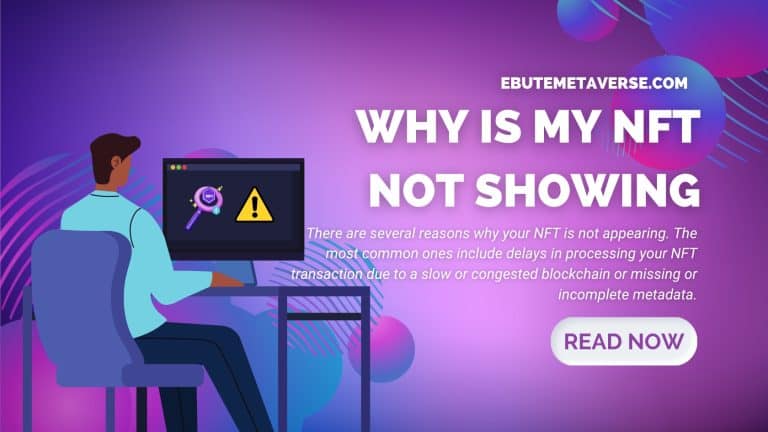NFT Smart Contracts Explained With Examples and Videos
A smart contract is a blockchain program used to implement a sales agreement between the owner of an NFT and a buyer. This programming is important because it ensures that the blockchain stores the information indicated in that NFT transaction without needing a third party.
What you’ll learn in this article:
What is an NFT Smart Contract?
A non-fungible token (NFT) smart contract is a programmatic code that runs on a blockchain to facilitate the creation, management, and transfer of NFTs. NFTs are unique digital assets representing ownership of tangible or intangible items like art, music, videos, collectibles, etc.
An NFT smart contract allows the tokenization of these real-world assets on the blockchain. Each NFT has a unique identification code and metadata that distinguishes it from other NFTs.
The smart contract contains the rules for generating the unique ID, validating ownership, executing transfers, and any other custom functionality.
Some key properties of NFT smart contracts:
- They provide proof of ownership of an asset by linking the asset to its digital representation (the NFT) on the blockchain.
- They allow true digital scarcity since each NFT is completely unique.
- The ownership records are transparent and immutable due to the decentralized blockchain.
- They facilitate automated transfers and trading of NFTs through the contract logic.
- They can include customized royalty schemas to reward the original creator on resales.
- Additional metadata, assets, and utilities can be associated with each NFT.
To sum up, NFT smart contracts make it possible to digitally store tangible and intangible assets on the blockchain and manage who owns what and how it can be transferred efficiently.
How NFT Smart Contracts Work (With Example)
An NFT contract contains the basic programming logic to perform the following functions:
- Minting: This refers to the initial creation of an NFT from a digital asset. The minting function generates a cryptographically unique ID and assigns ownership to the NFT creator.
- Metadata storage: The contract stores metadata related to the NFT such as title, description, image, attributes, external URL, etc. This data enables visibility and discoverability.
- Ownership transfer: To facilitate trading, the contract includes a transfer function that can switch ownership when one user transfers the NFT to another.
- Access control: The contract contains logic to determine who can call different functions and under what conditions. For example, only the owner may be allowed to transfer or burn the NFT.
- Royalty payments: The contract may implement a royalty system where a percentage of secondary sales is automatically paid out to the original minter.
- Burning: Permanently removing the NFT from circulation to create scarcity. Only the current owner can burn the NFT, typically.
- Enumeration: Returns a list of all NFTs minted by this contract. It is useful for marketplaces to display available NFTs.
- Querying: Functions to retrieve the current data associated with an NFT token ID, like metadata and ownership details.
These core functions are included in standard NFT contracts, like ERC-721 for Ethereum. Developers can also add custom logic and data structures suited for their specific applications.
When the user interacts with the NFT via the blockchain (e.g., by minting, buying, or transferring), the contract processes and records these state changes on the blockchain.
The updated data is then available to all network participants in a transparent and tamper-proof manner.
Let’s go through a simplified example flow to illustrate how an NFT contract works:

This demonstrates how the minting, transferring, and royalty payouts are automated via the smart contract code. Developers can continue adding more complex functionality on top of this core NFT logic.
NFT Smart Contract Standards
There are some widely adopted standards that provide a common interface for NFT contracts to integrate with marketplaces and wallets. The two most popular ones are:
ERC-721:
The ERC-721 standard pioneered by the CryptoKitties project has emerged as the de facto interface for NFTs on Ethereum. It employs the solidity programming language. Some key methods include:
- balanceOf: Check the number of NFTs owned
- ownerOf: Get owner of NFT by ID
- safeTransferFrom: Securely transfer NFT to another user
- approve: Grant permission to transfer NFT
- setApprovalForAll: Approve operator to manage all user’s NFTs
- getApproved: Get approved address for single NFT
- isApprovedForAll: Check if operator is approved for all NFTs
ERC-1155:
The ERC-1155 standard provides an interface for managing both fungible and non-fungible tokens in a single contract. Adds support for batch transfers, batch approval, and royalty fees. Some key methods include:
- balanceOfBatch: Get balances of multiple token IDs
- safeBatchTransferFrom: Batch transfer of multiple NFTs
- isApprovedForAll: Check if operator has approval for all tokens
- setApprovalForAll: Approve operator to manage all user’s tokens
These standards provide predictable interfaces that enable interoperability between platforms. However, developers can always create custom contracts with additional functionality beyond these standards.
Benefits of NFT Smart Contracts
Here are some of the key benefits that NFT smart contracts unlock:
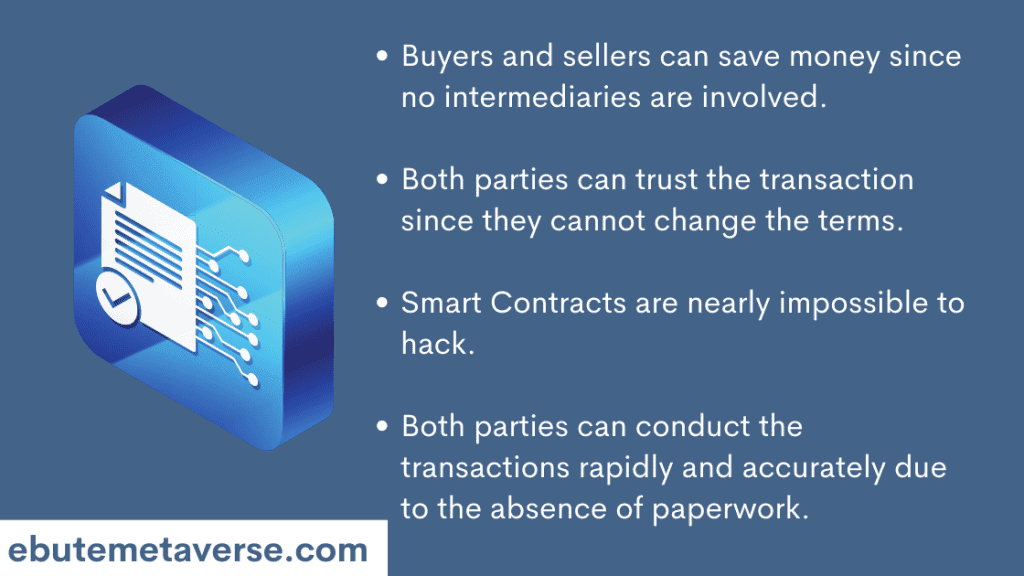
- Proof of ownership: Immutably records ownership of unique digital assets on the blockchain.
- Programmable Royalties: Creators can automatically earn royalties from secondary sales.
- Transparent history: Entire ownership history and transfer trail is visible.
- Interoperability: Standard interfaces allow easy integration with marketplaces and wallets.
- Automated transactions: All transfers happen programmatically through code without middlemen.
- Unified marketplace: Assets from multiple creators can be traded seamlessly on standards-compliant platforms.
- Custom business logic: Unique digital assets can have customized functionality and behavior.
- Reduced fraud: NFTs have built-in authentication that prevents fakes and frauds.
- High liquidity: Programmatic trading enables high liquidity and capital efficiency for assets.
- Composability: NFTs can be freely combined and composed into new derivative NFTs.
The programmability built into NFTs via smart contracts allows for endless possibilities when it comes to creating new types of digital assets and marketplaces.
Limitations of NFT Smart Contracts
However, there are certain limitations to consider as well:
- High development costs: Requires advanced programming skills and rigorous testing.
- Costly deployment: Deploying contracts and minting NFTs on Ethereum mainnet is expensive due to high gas fees.
- Security risks: Code vulnerabilities or weaknesses can lead to exploits and theft.
- Not easily upgradeable: Bug fixes and improvements require re-deployment and migration of assets.
- Standards still emerging: Evolving standards result in fragmentation and potential compatibility issues.
- Platform risks: If the underlying blockchain has outages, the NFTs will be impacted.
- Metadata mutability: Metadata about the NFT can still be changed even if ownership is immutable.
Over time, as blockchain platforms mature and standards stabilize, many limitations related to costs and risks will likely diminish.
Examples of NFT Projects Using Smart Contracts
Here are some popular NFT projects that are enabled by smart contracts:
- CryptoPunks: one of the first NFT projects on Ethereum with algorithmically generated collectible punk characters.
- CryptoKitties: digital cats that can be collected, bred, and traded using NFTs and smart contracts. The ERC-721 standard originated from this project.
- NBA Top Shot: Officially licensed NFTs of NBA video highlight moments It enables fans to collect and trade their favorite moments from games.
- Axie Infinity: a blockchain-based game involving collectible fantasy creatures called Axies that players can battle and trade using NFTs.
- Decentraland: a virtual world where players can explore, build, buy, and sell virtual real estate and other digital assets represented as NFTs.
- Bored Ape Yacht Club: A highly sought-after collection of 10,000 unique illustrated apes with algorithmically generated traits
- Sorare: a fantasy football game where users can collect limited-edition digital cards representing football players in the form of NFTs and manage fantasy teams.
These demonstrate just some of the innovative use cases made possible by representing unique assets on the blockchain using NFTs and smart contracts.
Building an NFT Smart Contract
Here are the typical steps for programmers to develop and launch an NFT smart contract:
- Choose a blockchain platform: Ethereum is the most popular currently, but alternatives like Flow, Tezos, Solana, etc., are also gaining traction. See a list of the blockchains that support NFTs.
- Select a language: Solidity for Ethereum, Cadence for Flow, Michelson for Tezos, etc.
- Include interface standards: Like ERC-721 or ERC-1155, to maximize interoperability.
- Write contract logic: Core NFT functions + custom programming tailored to your use case.
- Test thoroughly: Cover all possible edge cases and user flows. Use unit tests, console.log debugging, simulations, etc.
- Audit: Conduct a security audit to identify any vulnerabilities before mainnet deployment.
- Deploy contract: Deploy it on the target blockchain mainnet/testnet. Take note of the deployed contract address.
- Mint NFTs: Start interacting with the contract by creating NFTs, listing them, etc.
- Monitor analytics: Track contract activity like mints, transfers, royalties, etc., to gain insights.
- Upgrade contract: Add new features or fix issues by deploying an updated contract and migrating data.
It takes strong programming skills and blockchain knowledge to properly develop, test, and launch an NFT contract. Beginners can start by learning from sample contracts, documentation, and building simple contracts. You can also hire a developer on Fiverr or Upwork.
NFT Smart Contract Templates
Here are some open-source NFT contract templates that can be customized:
- ERC-721 contract: Basic NFT standard template contract in Solidity by OpenZeppelin
- ERC-1155 contract: Multi-token standard template by OpenZeppelin
- NFT Marketplace: Full stack NFT marketplace with contract code
- LAVA NFT contract: More advanced contract with staking and bonding
- CryptoPunks contract: One of the first NFT projects on Ethereum
Developers can use these templates to kickstart their own NFT project and customize the logic for their specific requirements.
How to Write an NFT Smart Contract (With Video Tutorial)
Here are some tips for developers when programming an NFT smart contract:
- Use a framework: Build on established tools like OpenZeppelin to save time and ensure best practices.
- Make state changes explicit: Avoid side effects. Explicitly emit events for actions like minting, transferring, etc.
- Validate inputs: Use require() to validate all function arguments and revert on failures. Prevent unexpected conditions.
- Use modifiers: Split code into logical modifiers for readability and reusability.
- Follow standards: Use interfaces like ERC-721 to maximize compatibility and interoperability.
- Comment thoroughly: Use NatSpec comments so others understand the contract logic.
- Limit minting: Use rate limiting and access controls to prevent over minting.
- Lock down transfers: Make transfers only possible by owners to prevent unauthorized transfers.
- Test exhaustively: Cover every function with unit tests and account for edge cases.
- Consider upgradability: Make future improvements easy by building in upgradability where possible.
- Plan for mainnet: Design architecture, storage and gas costs for production mainnet needs.
- Audit rigorously: Conduct professional audits to identify and fix all security vulnerabilities.
Following best practices and standards when writing the smart contract code maximizes the chances of creating a successful and secure NFT project on the blockchain.
Conclusion
Frequently Asked Questions
What is an NFT Smart Contract?
An NFT smart contract is an unchangeable, self-executing line of code that forms the basis of a non-fungible token. They govern the creation, purchase, and sales of NFTs on a blockchain.
How do NFT Smart Contracts Work?
NFT smart contracts work by assigning ownership or managing the transfer of that NFT. They also execute different actions coded into the asset, such as NFT royalty payments, without the need of a third party.
Is NFT a Cryptocurrency?
No, NFTs are not cryptocurrencies, although they exist on a blockchain. Rather, they are unique tokens that indicate digital or real-world asset ownership.
How do Smart Contracts verify Authenticity?
Smart contracts verify authenticity by tracing the history of how artists created that NFT and how it was linked to that blockchain. It can also verify a token’s linked metadata and its wallet’s address.

